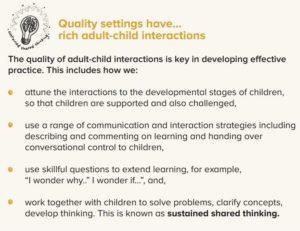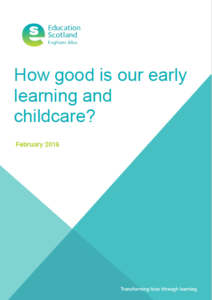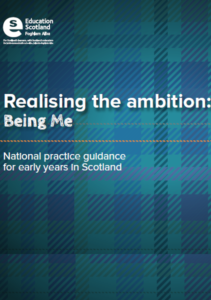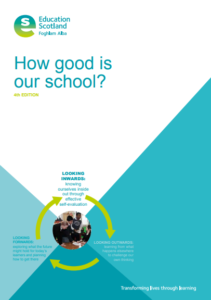p26 Interactions for WELLBEING
p28 Interactions for MY MOVEMENT AND COORDINATION DEVELOPMENT
p30 Interactions for PROMOTING MY CONFIDENCE, CREATIVITY & CURIOSITY
P69 Interactions to DEVELOP MY LEARNING
P82

p6
As we said in the Early Learning and Childcare Quality Action Plan in 2017, and I hope is clear from this new resource, the quality of the interactions that children have with adults who are caring for them fundamentally affects not only their enjoyment of early learning and childcare but also the contribution that this makes to their development.
p15
We often talk about the environment in terms of physical spaces, but the key part of the environment for children is the human, social environment of positive nurturing interactions.
p15
We need to be confident we are providing the kind of rich culture, including high quality experiences and sensitive interactions in a variety of outdoor and indoor spaces, which will develop in babies, toddlers and young children, the emotional resilience they need to form a secure wellbeing base
p17
Positive loving relationships are essential to the baby’s health and wellbeing, and helps shape their growing self both now and in the future (Robin Balbernie, Pre-Birth to Three LTS, 2010).
p46
Interactions are central and key to successful play pedagogy.
p52
These intentions must be supported by high quality interactions and warm caring relationships. Relationships which are well judged and focussed on extending and deepening children’s skills as lifelong learners.
p65
Remember that your interactions with the child are a key aspect of the learning environment. Carefully consider when to step in and when to step back – this is a skill even the most experienced of us can often misjudge!
p70
Interactions are at the heart of playful literacy development. Careful observations form part of building a picture of where a child is in their learning and determining what they need from us and environment around them to assist further learning. We should tap into what we know about the child’s interests and family life to attach talking, listening, reading and writing to meaningful environments and experiences created within settings.
p73
Enrich and extend my verbal and non-verbal interactions using familiar and unfamiliar language and vocabulary.





